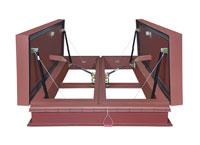Bilco - How to Select the Proper Sound Rating for Automatic Smoke Vents
 Bilco - How to Select the Proper Sound Rating for Automatic Smoke Vents
Bilco - How to Select the Proper Sound Rating for Automatic Smoke Vents
Diving into the world of acoustical ratings is like opening a can of alphabet soup. You are unsure which letters will float to the top, what their significance is and how to unscramble and define the mishmash of letters staring at you.
While there is a jumble of letters, the critical ratings for determining the acoustical quality of building products fall into two groups: Sound Transmission Class (STC) and Outdoor-Indoor Transmission Class (OITC). Depending upon the structure being built and the application of the products, the difference in the ratings is essential for architects, designers and construction teams to understand.
STC measures the extent to which sound is prevented from being transferred from one area to another. The higher the STC value, the less that sound can be transferred through a building product. STC is typically used to measure sound transmission loss over a frequency range from 125 to 4000 hertz and is most applicable for interior areas that experience mid to high frequency noises, such as conversation, television, telephones, and office equipment. A product with a high STC value, ranging from 50-60, indicates that loud speech is barely heard, if at all. A low STC rating, 20-25, indicates that loud speech is audible.
OITC rates the transmission sound between outdoor spaces and indoor spaces in a structure. Like the STC rating, OITC measures sound intensity loss in decibels. The OITC rating was developed in 1990 and is typically used to measure sound transmission loss over a frequency range from 80 to 4000 hertz. It is most applicable for measuring the prevention of low frequency exterior sounds such as automotive traffic, construction, and low-flying airplanes through exterior building surfaces.
How does this apply to automatic smoke vents? It is essential that building designers understand the source of noise, and how they can best diminish its impact.
“OITC is the preferred rating when addressing sound insulation from exterior noise – especially when transportation noise sources are impacting a building facade with significant low-frequency (bass) sound,” says Harold Merck, principal and acoustician for Merck & Hill Consultants of Atlanta. “While STC ratings may be fine for typical interior noise sources such as voices, STC does not adequately address the extended low-frequency noise contribution of aircraft, traffic or even large roof-top equipment. This also applies to large roof-top equipment noise sources as well. The OITC better addresses low-frequency noise impacts and is the more applicable sound rating for roof mounted automatic smoke vents.”
Like automatic smoke vents, the same theory holds true for exterior building windows. “Windows might have an excellent STC rating, but without a high OITC rating, low-frequency sounds can be intrusive,’’ Merck said. “Windows with a high STC rating typically have the same OITC rating as windows with a lesser STC rating, which can be a bit misleading. Ratings that include the OITC are more useful to assess how well a window will isolate environmental noise.”
Automatic smoke vents are life safety products that are generally used in large one-story buildings per National Fire Protection Association (NFPA) standards. In the event of a fire, the vents exhaust smoke, heat and burning gases from the building to improve visibility and to protect the building structure. This provides safe egress for building occupants and allows fire fighters to enter the building and contain the fire. When specifying automatic smoke vents, it is important to consider a product with an acoustical sound rating for applications such as theatres and concert halls, or projects located near highways, airports, or railroad lines.